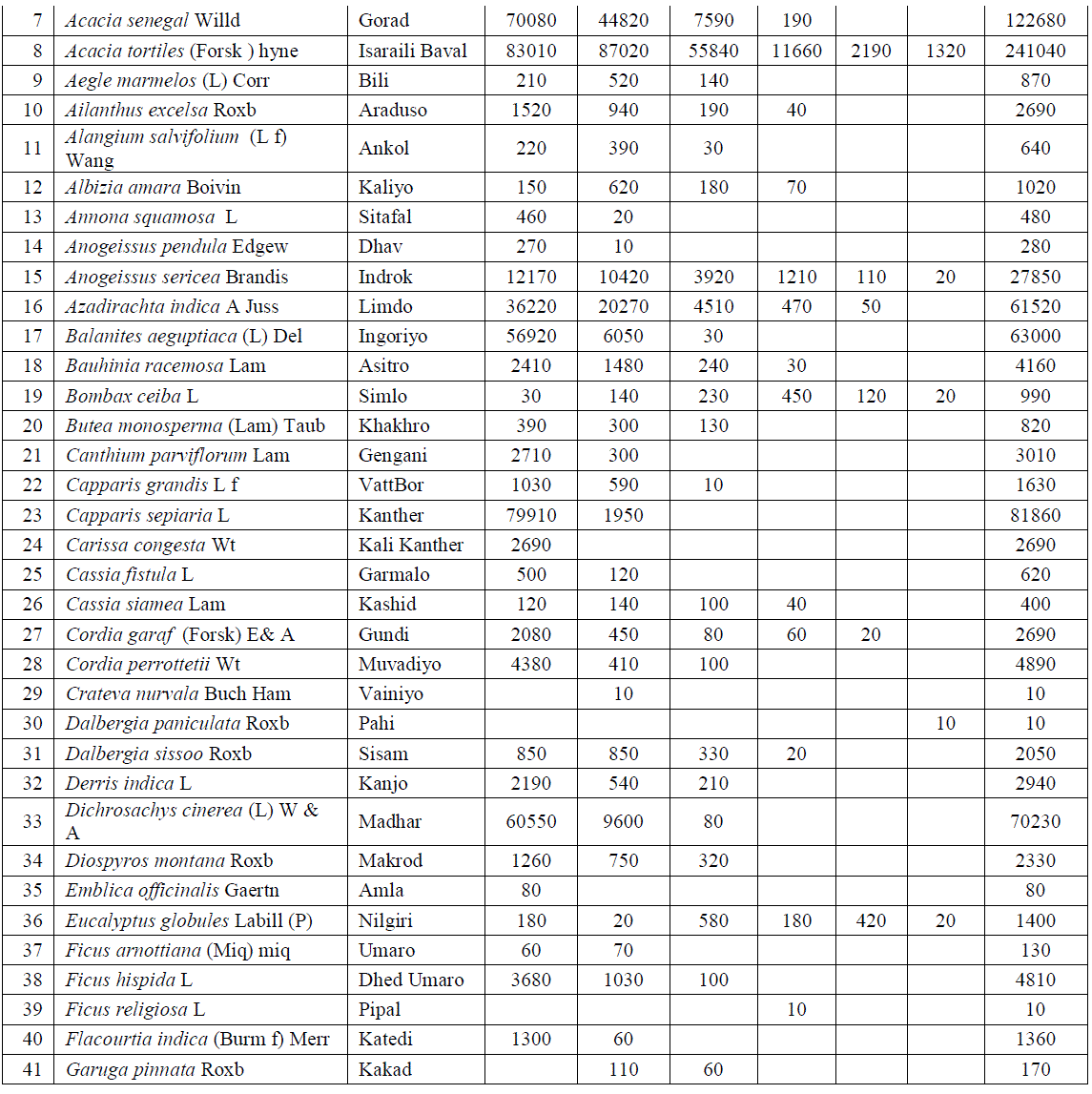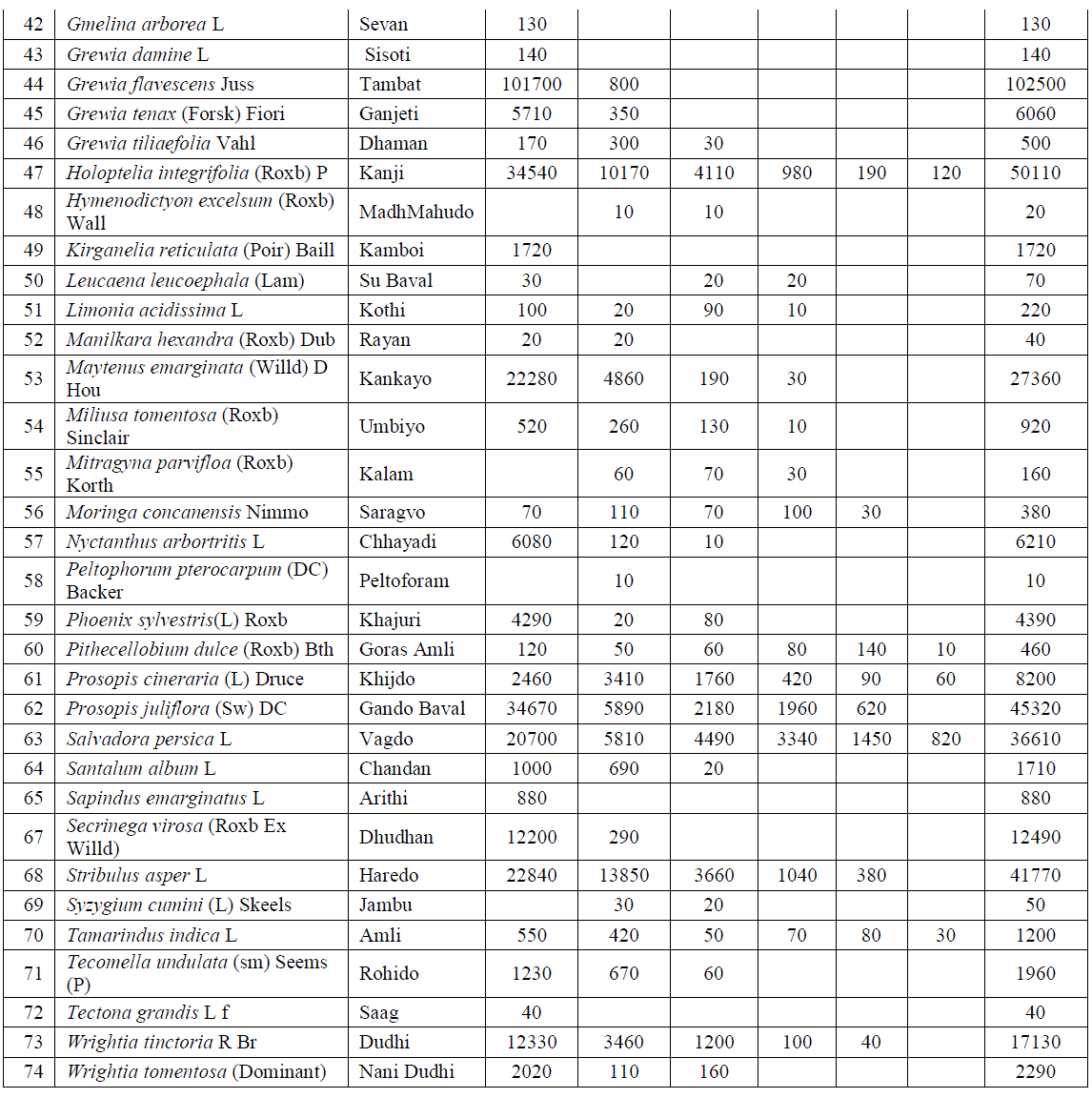ISSN ONLINE(2319-8753)PRINT(2347-6710)
ISSN ONLINE(2319-8753)PRINT(2347-6710)
Yogesh B Patel1, Ruby G Patel2 and H A Pandya3
|
| Related article at Pubmed, Scholar Google |
Visit for more related articles at International Journal of Innovative Research in Science, Engineering and Technology
It was during late-sixty and early seventies that the forest area of the state was sampled for knowing the growing stock. It was conducted by pre-investment survey now known as forest survey of India, Dehradun, India to know how much supply of raw material is possible from forest resources. Gandhinagar Forest Division has 48 villages and area of 11,263.31 hectare. It was surveyed covering the entire area in 20 meter wide strips laid parallel to each other with 200 m distance from one another. Strip enumeration methodology was thus adopted. Range wise details enumeration revealed that in Attarsumba range is rich range with 12,35,650 trees and available tree species are 78.
Keywords |
| Tree enumeration, Attarsumba range, Gandhinagar forest division. |
INTRODUCTION |
| Biodiversity of plant forms like trees and shrubs constitute the important component of the forest. Though the number of species belonging to trees and shrubs are comparatively less than that of herbs and climbers, the former groups dominate the forest cover due to their wide spread canopy coverage. Contribution of trees and shrubs to the total biomass of any forest is much higher than that of any other biotic component. Being perennial in nature and due to long life span, trees and shrubs supply Non Wood Forest Products (NWFP) year after year, besides the supply of timber. The NWFPs obtained from plant resources, including seeds, flowers, Fruits, leaves, roots, bark, latex, resins and other plant parts have gained much attention for conservation now. The growing commercial trade of natural products, in particular plant medicines and crafts, has resulted in overexploitation (Ticktin, 2004 [1]). Forest dwellers have remained dependent for their livelihood on trees and shrubs. They not only provide timber and firewood, but they act as a sustainable source of several kinds of non-wood forest produce to forest dwellers. It is important to know important NWFP trees in an area. |
II. LITERATURE SURVEY |
| Maximum benefits, in term of utility of trees and shrubs over a long period of time, can be reaped through the assessment of the total stocks of different species in terms of their number, density and spread over different girth classes in an area. It is, therefore, important to enumerate the trees and shrubs in an area (Tyagi et al, 2007 [2]; 2009 [3]). It was in the year of 1967, a survey covering all forest areas of Gujarat state was carried out. Tree species, their number in different girth class, their total number and their density could be known at that time from the survey. Since then, there has been lot of changes in composition of forests with increasing abiotic and biotic factors influencing them. Therefore, current assessment of Forest Resource is very much needed (Tyagi et al, 2007 [2]; 2009 [3]). The management of India’s forest resources is the key to progress in the field of agriculture and allied sectors, infrastructure, rural, health and hygiene, water conservation and to overall socio-economic development (Bahuguna, 2000 [4]). |
| Importance of tree enumeration: Tree enumeration data can compare with remote sensing, calculating green cover, calculate available carbon stock in forest area, to balance biodiversity conservation, nitrogen fixation, to save native community from invasive species, ensuring their sustainability and stable ecosystem. |
| Present Forest Resource survey was undertaken to create database in Gandhinagar forest division for the due revision of working plan. It was established by the investigations that some species are holding on and growing successfully in the area with dominant replacement to other tree species in the forest range. |
| Gandhinagar range is divided in three ranges. Attarsumba range, Dharoi range and Mansa range. As Attarsumba range is reach in production of NWFPs which have good market and medicinal value, it has been selected for present study. Percentage contribution to worth/income for various NWFPs in decreasing order of their contribution is as: Baval gundar (39%), Shatavari mool (27%), Dholi musli (12%), Chanothi pan (10%), Madh (4%), Limbodi (2%), Kakarash beej (2%), Kher (2%), Puvaad beej (1%) and Piluda mool (1%). Population living near or in forests have a long history of Non-wood Forest Products (NWFP) extraction for substance or sale. NWFPs make an important contribution to the livelihood of those households who gather and consume them (Jasrai et al, 2014 [5]). |
Statement |
| ïÃâ÷ Plant composition and configuration that persisted before changed over a period because of variations in climatic conditions. |
| ïÃâ÷ This requires a careful planned and detailed forest resource survey for necessary inputs for evaluation and analysis with meticulous planning for conservation, protection and development of forest in desired form. |
| ïÃâ÷ People from villages on the fringes of forests collect several NWFPs from the forest. |
| ïÃâ÷ These forest resources are essential to understand required database on dependency of local people on forests. |
| ïÃâ÷ This survey was conducted to document a database to help and generate prescriptions for future plans to be adopted. Total forest area covered by this division is about 11263.31 hectare, out of which 6390.11 hectare is reserved forest, 44.92 hectare is protected forests and the remaining 4828.28 hectare forest areas is yet to be settled. The same forest area of 4828.28 hectare has been notified under Section 4 of Indian Forest Act, 1927 (Anonymous, 2008 [6]). |
| The forest included under this division is distributed over 18 villages of Kapadvanj Taluka of Kheda district (Anonymous 2002 [7]). According to Champion and Seth (1968) [8] the revised classification of forest type (Table-1), |
 |
III. MATERIALS AND METHODOLOGY |
| The map of the Gandhinagar Forest Division was stratified in 48 villages on the basis of density-composition of species of the particular forest area. |
Species enumerated: |
| A list of common tree species in the area to be enumerated was prepared before starting the work. Every strip along the base line was enumerated; thus covering a 10 % enumeration. All the tree species occurring in the forests were enumerated in terms of girth classes as 0-30 cm, 31-60 cm, 61-90 cm, 91-120 cm, 121-150 cm and above 150 cm. The tree species encountered in the enumeration survey was also collected for herbarium preparation and correct identification. |
| The most important part is the correct location of the starting point on the field based on the point marked on the village map. The help of local people and the forest department staff was also essential. This was ascertained with available features on the ground and a peg was fixed at this point with details (corresponding to the details on the map). |
Establishing strip-line on the base-line and enumeration work |
| The first cruise-line was fixed at right angle to the base line, at 100 m from the starting point. The straight line of cruise-line was created and continued exactly as followed for the base-line with the help of Flagman. |
| For every 250 m length of the strip, one tree-enumeration form was done. That means, if the strip is 750 m long as per the map, then tree forms are to be filled-up accordingly. |
IV. RESULT AND DISCUSSION |
| The data on tree enumeration was collected during the survey and analysis for the period 2012-2014. The entries in the enumeration format for each 12.5 m length of up and down strip of each village surveyed were feed to the prepared computer table. The total stock of each surveyed village was calculated. The results were compiled to get total stock of the stratified village and range of the division. |
| The species-wise data was also analyzed. The entries of each of the surveyed villages were collected to get the species-wise total stock for each village in the range. Thus, the stock of each village surveyed was calculated by multiplying stock (10% as surveyed data) in each girth class by 10. Plant identification was done with the help of forest flora of Gujarat state Patel, R. I. (1984) [9] and Flora of Gujarat State Part I &II by Shah G. L. (1978) [10], Cook (1901-1908) [11], Deshpande et al 1993 [12]. |
 |
 |
 |
 |
V. CONCLUSION |
| Attarsumba range has 23 villages. Total number of species present in the range was 78. At Attarsumba range, the ground flora was dense and varying due to high humidity of Vatrak River passing through the range. Thus the plant diversity was high in comparison to neighboring Mansa range. This density of tree species needs enhanced protection measures rather than new plantation at the range. |
| Range is mainly dominated by Acacia tortiles (Forsk) hyne (2,41,040 trees). It makes 25% of the total tree stock (12,35,650). Acacia Senegal Willd (1,22,680), Zizyphus nummularia (Burm f) W & A (1,11,590), Grewia florescence Juss (1,02,500) etc. are the other leading species surveyed in Attarsumba range. In higher girth class (above 150cm), the tree are like Acacia tortiles (Forsk) hyne (1,320), Salvadora persica L (820), Acacia nilotica (L) Dell (170), Holoptelia integrifolia L (120) dominating. In the range, maximum covers were found in lower classes (Table-2). At Attarsumba range, the gigantic and heaviest Bamboosa arundinacea (Retz) Wiild – Bamboo (Local name-Vans), clumps were observed in flowering stage at Vaghjipur village. This is a rare phenomenon that though massive but observed in less number in good conditions for this particular forest range. |
References |
|